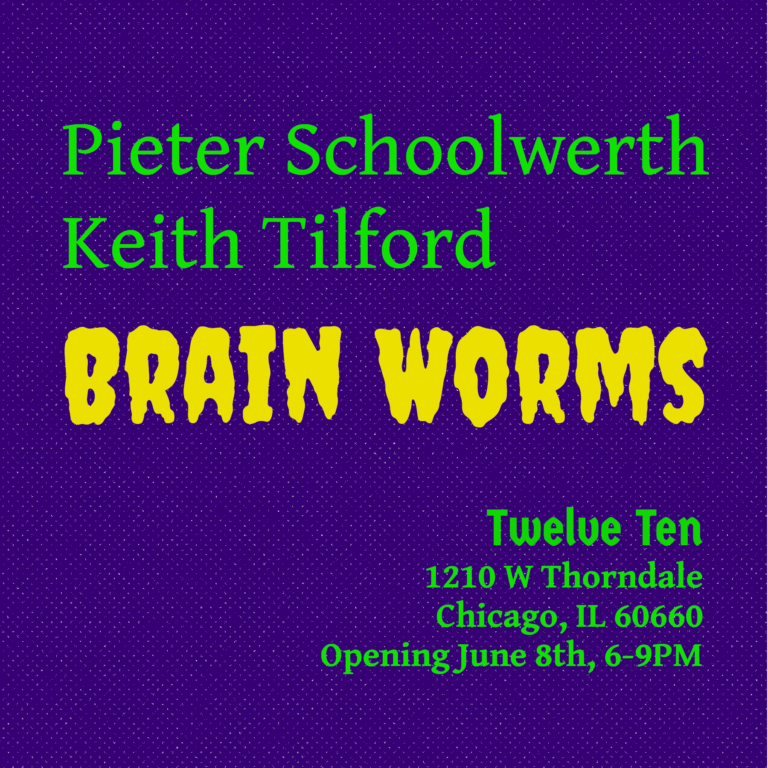Pieter Schoolwerth and Keith Tilford: Brain Worms
@ Twelve Ten Gallery
1210 W Thorndale Ave, Chicago, IL 60660
Opening Saturday, June 8th, from 6PM - 9PM
On view through Saturday, July 27th
Twelve Ten Gallery is pleased to present work by Pieter Schoolwerth and Keith Tilford.
In the cult film “Brain Damage” (1988), director Frank Henenlotter introduces a loquacious, brain eating parasite, called Aylmer, that looks like a cross between a penis and a fluke worm. Aylmer attaches himself to Brian (Rick Hearst), whom he seduces with his honeyed tongue and the addictive properties of a psychoactive chemical called “juice” that he injects into Brian’s brain stem.
Philosopher Michel Serres identified the parasite as an agent of exchange: “The parasite invents something new. Since he does not eat like everyone else, he builds a new logic. He crosses the exchange, makes it into a diagonal. He does not barter; he exchanges money. He wants to give his voice for matter, (hot) air for solid, superstructure for infrastructure.” What is the new thing that the parasite invents? Serres tells us that “He invents cybernetics.” Aylmer pilots Brian like an automaton as he exchanges juice for brains.
Schoolwerth’s paintings appropriate a variety of computer generated models as raw material for their imagery. Sourcing these models from online marketplaces, he implicates the work in the anonymous transactional flows of transnational cyber capital. Accompanying the paintings are a series of videos that Schoolwerth created in collaboration with animator Phil Vanderhyden and sound designer Aaron Dilloway. Disturbing and humorous in equal measure, the bodies in these works twitch and jerk unnaturally as if puppeteered by a malign influence. Situated as both subjects and objects of a process of rapid production and instant consumption, these virtual avatars are animated by global forces of exchange beyond their immediate ken or control.
Tilford presents a digitally printed mural of AI generated images, which is overlaid with a series of hand-executed drawings. His drawings serve as the base material fed into generative models, producing artifactual renderings that appear to be ripped from sci-fi blockbusters. His arrangement of these images recall the layout of comic pages or the taxonomic displays of natural history museums, as if indexing weird species discovered on strange excursions. Tilford’s drawings themselves abstract from the commercial illustration techniques of comics, but it is precisely this vernacular of illustration from which the tech-industry uses AI to extract surplus value. Tilford makes us question which is predator, prey or parasite as man and machine seek to consume one another in a contest of pattern recognition.
In Schoolwerth and Tilford’s works we get the sense that there remains the intervention of a particularly human craft, or craftiness, that is transformed by the parasitic exchange of capital’s accelerating creative destruction and cybernetic reinvention of human labor.
Schoolwerth continues to investigate the dichotomies between painting/not-painting and abstraction/representation. His work folds the logic of these oppositions back into itself through a complex series of technical operations. Having experimented with tracings, sculpture and relief, printing, and paint itself, digital media has become increasingly important to Schoolwerth as the territories of his practice widen. Nonetheless, he has maintained a dedication to painting, even as his engagement with new techniques and digital tools has “expanded the field”.
Tilford’s work is rooted in the tradition of comics, a relatively recent artform that he recognizes as having developed its own parallel genealogy to modernism and abstraction. Largely ignored or dismissed by art history, the comics medium contains a rich synthesis of language and the visual arts which makes it difficult to classify according to more traditional historical narratives, but uniquely positioned to investigate the processes of artificial image generation and how it reconfigures our understanding of the imagination.
At the end of “Brain Damage” Brian tries to quit Aylmer, only to be told by the parasite that his brain chemistry has altered irrevocably and he will never be able to live without him. Unable to overcome his addiction, Brian is injected with a massive overdose of juice. Rather than killing him, however, Brian’s skull cracks open, revealing a glowing window. As the camera zooms out, waves of light crackle from Brian’s head as we are presented with this new, transcendent manifestation of his relationship to the parasite.
Pieter Schoolwerth (b. 1970, lives and works in Brooklyn, New York) works in a multitude of mediums including painting, sculpture, installation, and video. Since graduating from the California Institute of the Arts in 1994, Schoolwerth has exhibited nationally and internationally with notable solo shows at Thread Waxing Space, New York; Greene Naftali, New York; Grand Palais, Paris; Miguel Abreu Gallery, New York; What Pipeline, Detroit; Capitain Petzel, Berlin; Kraupa-Tuskany Zeidler, Berlin and Petzel, New York. His work has been included in group exhibitions at The Museum of Modern Art, New York; The Whitney Museum of American Art, New York; Centre Pompidou, Paris; The Aldrich Museum of Contemporary Art, Ridgefield; The Institute of Contemporary Art, Boston; Sadie Coles, London among others. From 2003–2013 Schoolwerth ran Wierd Records (http://www.wierdrecords.com) and the Wierd Party in the Lower East Side of NYC, releasing music by 46 bands and producing over 500 live music, DJ, and performance art events.
Keith Tilford (b. 1978) is an artist and writer based in Brooklyn, NY. He illustrated the graphic novel Chronosis (Urbanomic, 2022) co-created with Robin MacKay and Reza Negarestani. Tilford has been an instructor for Foreign Objekt’s Intelligence/Computation Lab and a Visiting Tutor for Dutch Art Institute. Recent essays include “Grand Theft Autoencoder” (2024), “Performing Creativity: Text to Image Synthesis and the Mimicry of Artistic Subjectivity” (2023), and “Diagramming Horizons Between Art, Technē, and the Artifactual Elaboration of Mind”.
Official Website
More events on this date
Tags: Brain Worms, Chicago, Edgewater, Keith Tilford, Pieter Schoolwerth, Twelve Ten Gallery

« previous event
next event »